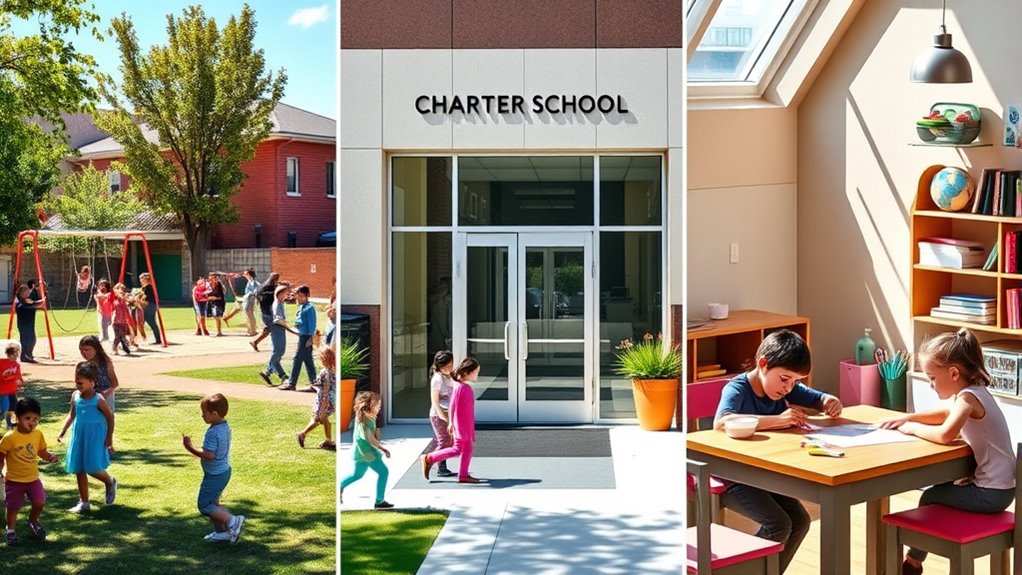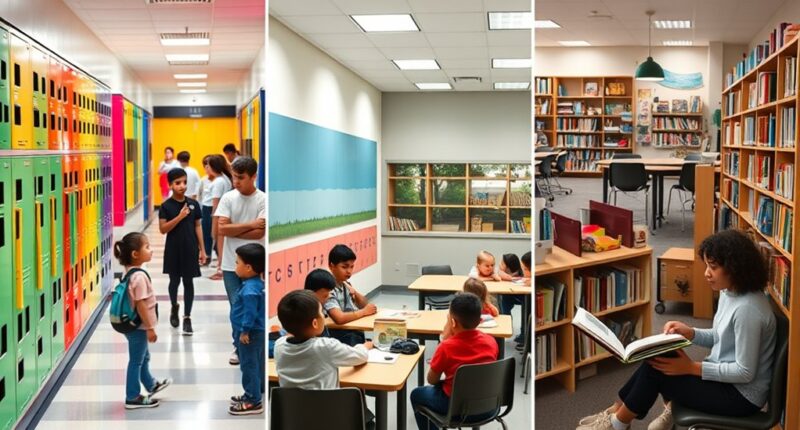Public schools often offer large classes with diverse peers and structured community activities, but may feel less personal. Charter schools usually provide smaller classes and more innovative programs, fostering stronger connections. Homeschooling allows you to tailor learning and social activities outside traditional settings, giving you full control. Each option shapes community involvement differently. To understand how these environments impact your child’s experience and connections, keep exploring each approach in detail.
Key Takeaways
- Public schools offer large, structured classrooms with diverse social interactions and access to extensive resources.
- Charter schools feature smaller classes, innovative curricula, and foster closer community involvement.
- Homeschooling provides a highly personalized environment with flexible social activities outside traditional settings.
- Parental involvement varies, with homeschooling requiring full participation and charter schools encouraging collaboration.
- Community engagement is more embedded in public and charter schools, while homeschooling relies on external resources and activities.

Deciding between public school, charter school, and homeschooling can be challenging because each option offers different benefits and challenges. Your choice impacts not only your child’s education but also their social interactions, the classroom environment, and the level of parental involvement. Public schools tend to have large, structured classrooms with a set curriculum, which can provide consistency and access to specialized resources. However, the classroom environment in public schools might sometimes feel crowded or less personalized, making it harder for teachers to cater to individual needs. As a parent, your involvement can vary; some schools encourage active participation through parent-teacher organizations or volunteering, while others may have less flexible avenues for parental engagement. This environment can influence your child’s learning experience, especially if they thrive in more intimate, tailored settings. Additionally, the use of technology and digital tools in classrooms can enhance learning but requires access and familiarity with such resources.
On the other hand, charter schools often offer a different dynamic. They usually operate with more flexibility in curriculum design and teaching methods, which can foster a more innovative and engaging classroom environment. Because charter schools often have smaller class sizes compared to traditional public schools, your involvement as a parent can be more direct and impactful. You might find more opportunities to collaborate with teachers and participate in school activities. This involvement can help reinforce your child’s learning at home and ensure their educational experience aligns with your family values. Additionally, the focus on community and unique teaching approaches in charter schools can create a more personalized atmosphere, making it easier for your child to connect and thrive.
Homeschooling provides a completely different experience, giving you full control over your child’s education. You design the curriculum, choose resources, and set the pace, creating a classroom environment tailored specifically to your child’s needs and interests. While this level of customization can be highly beneficial, it also demands a significant time commitment and active parental involvement. You’re not just overseeing your child’s education but often teaching directly and managing their social activities. This approach allows for a highly personalized and flexible learning environment, which can be especially advantageous for children with specific learning styles or needs. However, it also means that your involvement must be consistent and deliberate, as you’re responsible for creating a positive classroom atmosphere and ensuring your child stays motivated and socially engaged with peers. Furthermore, access to specialized educational tools and community resources can enhance the homeschooling experience and support your child’s development.
Ultimately, each educational path offers distinct benefits and challenges related to classroom environment and parental involvement. Your decision will depend on your child’s learning style, your capacity to be actively involved, and the kind of community environment you want to foster in their education.
Frequently Asked Questions
How Do Community Values Influence School Choice Decisions?
Community values greatly influence your school choice decisions by shaping your preferences through community engagement and cultural influences. You might prioritize schools that reflect local traditions or support community goals, feeling more connected when your values align. These factors guide you to select educational options fostering cultural identity and community involvement, ensuring your child’s education resonates with your community’s beliefs. Your choices often mirror collective priorities and cultural nuances that matter most to your community.
What Long-Term Social Impacts Differ Among These Education Types?
You’ll notice that long-term social impacts vary across education types. Public schools often foster diverse peer interactions and promote civic engagement, building community cohesion. Charters might emphasize innovation but can limit exposure to broader social groups. Homeschooling may reduce peer interactions, potentially impacting social skills and civic awareness. These differences shape how individuals develop social networks, civic responsibility, and community participation over time, influencing societal cohesion and mutual understanding.
How Do Families Manage Transitions Between School Types?
When managing shifts between school types, you often face transfer challenges like adapting to new routines and curriculum differences. To ease peer integration, you might encourage your child to participate in extracurricular activities or social events. Open communication with teachers and support staff helps address concerns and fosters a smoother switch. Planning ahead and maintaining a positive attitude can make your child’s transition less stressful and more successful.
What Role Do Local Policies Play in Shaping Community Perceptions?
Oh, the irony isn’t lost on you—local policies like zoning and state funding seem to secretly shape community perceptions more than personal stories do. While you might think opinions come from real experiences, it’s often these policies that set the tone. Zoning policies determine school boundaries, influencing community loyalty, while state funding can sway perceptions by supporting one type over another. So, policies quietly mold how you see your local schools.
How Do Extracurricular Opportunities Compare Across Options?
You’ll find that extracurricular opportunities vary widely depending on the educational option. Public schools often offer extensive sports programs and arts offerings due to larger budgets and resources. Charters may provide specialized programs aligned with their focus, while homeschooling allows you to tailor activities to your child’s interests, though you might need to seek external programs for sports and arts. Your choice impacts the variety and accessibility of extracurricular activities available to your child.
Conclusion
No matter which path you choose—public, charter, or homeschool—your decision reflects your love and dedication to your child’s future. It’s easy to worry about whether it’s the “right” choice, but your commitment matters most. Remember, each option has its challenges, but your involvement and care make all the difference. Trust yourself; your support can turn any learning environment into a place where your child truly thrives.









